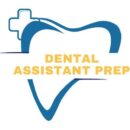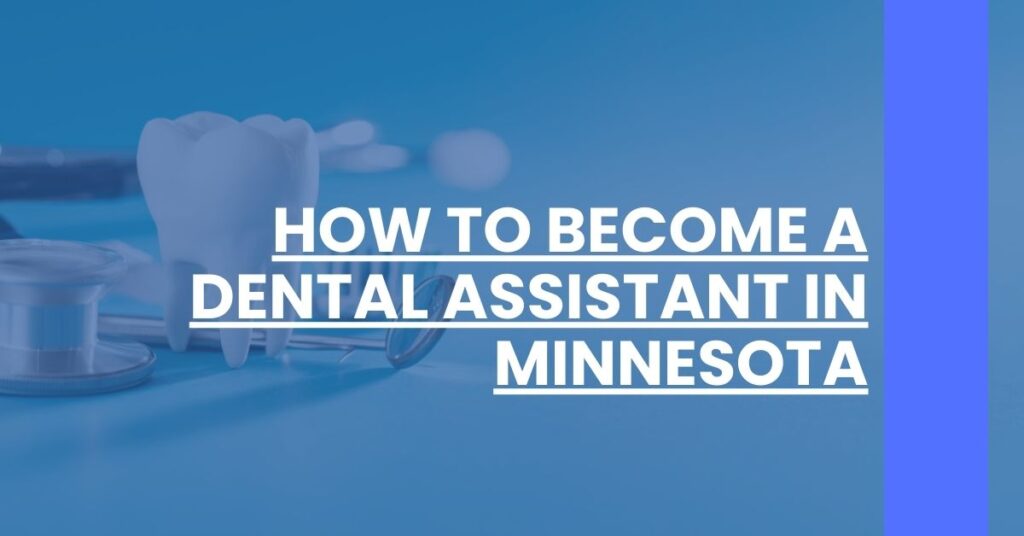Looking for programs in a specific city? Check out our lists of Dental Assistant Programs in Minneapolis, St. Paul, and Rochester.
How to become a dental assistant in Minnesota? Here’s your quick guide.
- Understand Dental Assistant Levels: Learn about Basic, Advanced, and Licensed Dental Assistants.
- Complete Educational Requirements: Obtain a high school diploma or GED and enroll in an accredited dental assisting program.
- Get Certified and Licensed: Pass necessary exams and meet state-specific requirements for certification and licensing.
Navigating how to become a dental assistant in Minnesota is straightforward with the right steps.
How to Become a Dental Assistant in Minnesota
Minnesota offers structured pathways for those who want to become dental assistants. Your journey includes understanding various dental assistant levels, meeting educational requirements, obtaining certification, and fulfilling licensure requisites.
Understanding Dental Assistant Levels in Minnesota
To become a dental assistant in Minnesota, you need to understand the different levels: Basic Dental Assistant (BDA), Advanced Dental Assistant (ADA), and Licensed Dental Assistant (LDA). Each level has distinct responsibilities and scopes of practice.
Basic Dental Assistant (BDA)
A Basic Dental Assistant performs fundamental tasks such as:
- Assisting the dentist during procedures.
- Sterilizing instruments and equipment.
- Taking dental impressions.
- Processing dental X-rays.
Advanced Dental Assistant (ADA)
An Advanced Dental Assistant engages in more complex procedures, which may include:
- Supporting the administration of anesthesia.
- Performing advanced supportive dental care tasks.
Licensed Dental Assistant (LDA)
A Licensed Dental Assistant undertakes expanded functions and more intricate clinical tasks, including:
- Placing dental sealants.
- Removing sutures.
- Administering nitrous oxide sedation.
To progress through these levels, you need additional education, certification, and clinical experience. A Licensed Dental Assistant holds the broadest scope of practice in Minnesota, providing a foundation for more significant responsibilities.
Educational Requirements
To become a dental assistant in Minnesota, start with the necessary educational qualifications. You’ll need a high school diploma or GED before enrolling in an accredited dental assisting program.
Accredited Dental Assisting Programs
Accredited programs provide key coursework and hands-on clinical training. They cover areas such as:
- Dental Anatomy and Physiology: Understanding the structure and function of dental tissues and organs.
- Infection Control: Implementing procedures to prevent the spread of infectious diseases.
- Dental Materials: Learning about materials used in dental practice, including their properties and applications.
- Radiology: Mastering techniques to capture diagnostic X-rays.
- Chairside Assisting: Gaining practical skills to assist dentists during various procedures.
Clinical Training
Clinical training is crucial for developing hands-on skills. This includes:
- Externships in Dental Offices: Offering real-world experience under professional supervision.
- Practical Experience: Performing dental procedures and techniques in a clinical setting.
Accredited programs ensure you meet industry standards and prepare you for certification exams.
Certification
Certification is a pivotal step to enhance your career as a dental assistant in Minnesota. The Dental Assisting National Board is the primary certifying body.
Certification Process
- Complete an Accredited Program: Graduate from a CODA-accredited dental assisting program.
- DANB Exams: Pass the Certified Dental Assistant (CDA) exam, which includes General Chairside Assisting (GC), Radiation Health and Safety (RHS), and Infection Control (ICE) components.
- Study Resources: Use DANB’s preparation materials, including study guides and practice tests.
Certified dental assistants gain a competitive edge in the job market and demonstrate a high level of competence to potential employers.
Licensing Requirements
In addition to national certification, Minnesota requires state-specific licensing for Licensed Dental Assistants (LDAs).
Steps to Obtain Licensure
- Complete the Application: Download and fill out the licensure application from the Minnesota Board of Dentistry’s website.
- Application Fee: Pay the required fee.
- Submit Documentation: Include proof of graduation from an accredited program, passing DANB’s CDA exam, and Basic Life Support (BLS) certification.
- Background Check: Undergo a criminal background check.
- State Exam: Pass the Minnesota State Dental Assistant Licensure Exam.
Accurate and complete submissions ensure timely processing of your application.
Accredited Dental Assisting Programs in Minnesota
Choosing the right program can significantly impact your career trajectory. Here are some notable accredited dental assisting programs in Minnesota.
Hennepin Technical College
- Length: 1 year (Diploma) or 2 years (A.A.S degree).
- Cost: Approximately $4,200 per year.
- Curriculum: Combines theoretical coursework with extensive clinical experience.
Hibbing Community College
- Length: 1 year (Diploma).
- Cost: Around $5,000.
- Curriculum: Focuses on chairside assisting, radiography, and dental office management.
Rochester Community and Technical College
- Length: 1-year diploma or 2-year A.A.S.
- Cost: Roughly $6,000 per year.
- Curriculum: Comprehensive training in dental materials, radiology, and infection control.
Your choice of program should align with your career goals and financial considerations. Accredited programs provide a robust educational foundation, preparing you for successful certification and licensure.
Certification and Licensing Requirements
To become a dental assistant in Minnesota, you must adhere to specific certification and licensing requirements. These steps ensure that you are well-prepared and meet state standards for quality dental care.
Certification through the Dental Assisting National Board
Certification through the DANB is a pivotal component for dental assistants aiming to practice in Minnesota. Completing an accredited program and passing the Certified Dental Assistant (CDA) exam demonstrates your competence and readiness.
How to Become Certified
- Graduate from a CODA-Accredited Program:
- Choose and complete a program recognized by the Commission on Dental Accreditation (CODA), which ensures a high-quality education.
- Take the CDA Exam:
- The CDA exam consists of three parts: General Chairside Assisting (GC), Radiation Health and Safety (RHS), and Infection Control (ICE).
- Study using DANB’s comprehensive resources, such as online courses, study guides, and practice exams.
- Submit Proof:
- Provide evidence of program completion and successful exam results to the DANB.
Passing the CDA exam not only meets certification requirements but also boosts your market credibility, potentially leading to higher earning opportunities.
Additional State-Specific Licensing Requirements
In addition to national certification, Minnesota has specific licensing processes that dental assistants must follow.
Minnesota State Licensure Application Process
- Fill Out the Application:
- Download the application form from the Minnesota Board of Dentistry.
- Accurately complete all sections to avoid delays.
- Pay the Application Fee:
- The fee is generally around $140.
- Ensure prompt payment to facilitate processing.
- Gather Necessary Documentation:
- Include transcripts from your accredited dental assisting program.
- Submit evidence of passing the CDA exam.
- Provide proof of Basic Life Support (BLS) certification for healthcare providers.
- Complete a Background Check:
- A thorough check is required to ensure you meet the state’s legal and professional standards.
- Pass the Minnesota State Exam:
- The state-specific licensure exam further assesses your readiness to practice as a Licensed Dental Assistant in Minnesota.
CPR Certification Requirement
Basic Life Support (BLS) certification is necessary for licensure. It encompasses CPR training and AED usage, ensuring you can respond effectively to emergencies within a dental practice.
Continuing Education and Professional Development
Maintaining your licensure involves continuous learning. Minnesota requires dental assistants to complete 25 CE hours every two years. This ongoing education helps you stay updated with advancements in dental care, focuses on critical areas such as patient management, infection control, and emergency preparedness, and enables you to advance in your career.
Approved CE Programs
Numerous institutions offer approved continuing education programs:
- University of Minnesota School of Dentistry: Provides a variety of courses both online and in-person.
- Minnesota Dental Association: Hosts workshops and seminars covering different facets of dental practice.
- Online Courses: Professional organizations often offer accredited online courses that can be completed at your convenience.
Professional Development Opportunities
- Advanced Certifications: Pursue additional certifications in specialized areas such as orthodontics or oral surgery assisting.
- Networking Events: Conferences and trade shows provide excellent networking opportunities and exposure to the latest industry practices.
- Career Growth: Advanced qualifications can lead to senior roles, increased responsibilities, and higher salaries.
Job Prospects and Salary Information
Minnesota’s growing demand for dental care services ensures robust job prospects for dental assistants. Employment of dental assistants is projected to grow 11% from 2020 to 2030, offering numerous opportunities across various settings.
Employment Settings
Dental assistants can work in diverse environments:
- General Dental Practices: Providing routine dental care.
- Specialty Practices: Working in fields such as orthodontics, pediatric dentistry, or oral surgery.
- Public Health Clinics: Serving the dental care needs of the broader community.
- Academic Institutions: Assisting in dental schools and training future dental professionals.
Average Salaries
Dental assistants in Minnesota earn an average salary of around $49,000 per year, which is higher than the national average. This competitive salary reflects the state’s commitment to quality dental care and the value placed on skilled dental professionals. Factors affecting earnings include experience, location, and the type of dental practice. Metropolitan areas usually offer higher salaries compared to rural regions.
Radiography Certification
To legally perform radiographic procedures in Minnesota, dental assistants must obtain radiography certification. This certification reflects your ability to handle dental X-ray equipment safely and effectively.
Steps to Radiography Certification
- Educational Component:
- Enroll in a radiography course within an accredited dental assisting program.
- Gain proficiency in patient positioning, radiographic techniques, and radiation safety.
- Pass the RHS Exam:
- The Radiation Health and Safety (RHS) exam, administered by DANB, assesses your knowledge and skills.
- Use available study guides and practice exams to prepare.
- Submit Certification Proof:
- Provide evidence of course completion and the RHS exam pass to the Minnesota Board of Dentistry.
Integrating Radiography Certification into Licensure
Radiography certification is often incorporated into the broader licensing framework for becoming a Licensed Dental Assistant (LDA), making it a critical step in your career.
Looking for Dental Assistant Information On States Bordering Minnesota?
In addition to Minnesota, we suggest looking for schools in nearby states.
- How to Become A Dental Assistant in Wisconsin
- How to Become A Dental Assistant in Iowa
- How to Become A Dental Assistant in North Dakota
- How to Become A Dental Assistant in South Dakota
- How to Become A Dental Assistant in Michigan
Conclusion
In summary, to become a dental assistant in Minnesota, you’ll need to complete an accredited educational program, obtain necessary certifications, and secure state licensure. With promising job prospects and competitive salaries, embarking on this career in Minnesota offers a rewarding opportunity. Continuous education and professional development will further enable you to grow and succeed in this dynamic field.
By following this structured guide, you can confidently embark on your journey to becoming a dental assistant in Minnesota, ensuring a successful and fulfilling career in dental healthcare.

